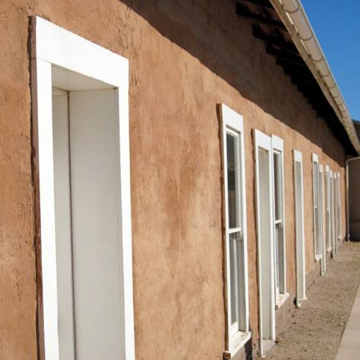You are here
Commanding Officer’s Quarters
George Alonzo Johnson (1824–1903), owner of the Colorado Steam Navigation Company, became a key figure in the development of Yuma Crossing when, around 1859, he built a house for himself and his wife, Maria Estéfana Alvarado (1840–1926), that would eventually be used as Commanding Officer’s Quarters for the Yuma Quartermaster Depot.
Johnson was a native of Palatine Bridge, New York, who followed the Gold Rush trails westward in 1849. After he arrived in Yuma, he re-established a ferry at Yuma Crossing with several partners but soon sold his shares in the successful ferry operation to turn his attention to bringing supplies up the river to isolated Fort Yuma. Following a failed attempt to use a pole barge in 1852, Johnson and a pair of partners secured a contract to supply the fort with a side-wheel steamboat, the General Jessup, starting in 1854. The Colorado Steam Navigation Company was the only steamboat operation on the river for most of its history and it made Johnson a rich man. After moving to San Diego in 1858, he built the house in Yuma to use when he and his wife returned for visits to the area.
Designed and built by a ship’s captain, the five-room house is a model of the efficient use of space, evident in its proliferation of built-in cabinetry. The one-story structure has two-foot-thick adobe walls and a wood shingle roof punctuated by two chimneystacks at the gable ends. The most significant feature is the wraparound veranda with a shed roof, supported by simple wooden posts. As was standard practice at the time, the kitchen occupies a separate structure, keeping excess heat out of the living quarters and reducing the danger of fire.
After the Yuma Quartermaster Depot was established in 1864, Johnson sold his residence to the U.S. Army for use as the Commanding Officer’s Quarters. When the depot closed, the U.S. Customs Service used the Commanding Officer’s Quarters for a time, after which it again became a private residence. Today, the former Johnson Residence is furnished much as it would have been more than 150 years ago. It is one of five extant historic structures that form the Yuma Quartermaster Depot State Historic Park.
Writing Credits
If SAH Archipedia has been useful to you, please consider supporting it.
SAH Archipedia tells the story of the United States through its buildings, landscapes, and cities. This freely available resource empowers the public with authoritative knowledge that deepens their understanding and appreciation of the built environment. But the Society of Architectural Historians, which created SAH Archipedia with University of Virginia Press, needs your support to maintain the high-caliber research, writing, photography, cartography, editing, design, and programming that make SAH Archipedia a trusted online resource available to all who value the history of place, heritage tourism, and learning.














